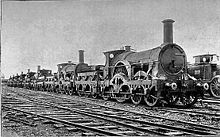GWR class Iron Duke
| GWR class Iron Duke | |
|---|---|
|
"HIRONDELLE" locomotive
|
|
| Number: | 30 24 "Rover class" |
| Manufacturer: |
Great Western Railway Swindon Works |
| Year of construction (s): | 1847–1855 1871–1888 "Rover" |
| Retirement: | 1892 |
| Axis formula : | 2A1 |
| Genre : | 4-2-2 ( Whyte notation ) |
| Gauge : | 2140 mm 7 ft ¼ in |
| Fixed wheelbase: | 5705 mm / 18 ft 8½ in 5795 mm "Rover" |
| Total wheelbase: | 5705 mm / 18 ft 8½ in 5795 mm "Rover" |
| Top speed: | 80 mph or 128 km / h |
| Driving wheel diameter: | 2440 mm or 8 ft |
| Impeller diameter front: | 1370 mm or 4 ft 6 in |
| Rear wheel diameter: | 1370 mm or 4 ft 6 in |
| Cylinder diameter: | 457 mm or 18 in |
| Piston stroke: | 610 mm or 24 in |
The Class Iron Duke was a series of broad gauge - steam locomotives for express trains of the Great Western Railway .
overview
A prototype called Great Western , built under the direction of Sir Daniel Gooch in the Swindon Works , was initially delivered with the 1A1 wheel arrangement in 1846 , but after a break in the front axle, it was soon converted into the 2A1 axle arrangement with an additional axle. The series locomotives of the same type, which were created between April 1847 and July 1855, had the same wheel arrangement and were referred to as the Iron Duke class. The machines received an external frame with an internal engine. All wheelsets were firmly mounted in the frame, the driving axle was without flange.
commitment
For the time, these machines were at top speeds of 80 mph or 128 km / h particularly fast. They were used for the Flying Dutchman Express , which made it the fastest train in the world for several decades. The route from London Paddington Station to Exeter (194 miles or 310 km) was completed at an average speed of 53 mph or 85 km / h, on the flat section between London and Swindon even almost 60 mph or 96 km / h cruising speed reached.
Class definition
From 1865 the locomotives of the Iron Duke Class were run as the Alma Class . In 1870 three machines were extensively rebuilt. These new buildings of the same type, which were subsequently built between 1871 and 1888, were then referred to as the Rover class . Apart from the three modifications, the original Iron Duke machines were decommissioned between December 1870 and June 1884 and the "Rover" variants until 1892.
Single copies
The years indicate the commissioning and retirement.
Iron Duke class
- Alma (1854–1872)
- Amazon (1851–1877)
- Balaclava (1854–1871)
- Courier (1848–1877)
- Crimea (1855–1876)
- Dragon (1848–1872)
- Emperor (1847-1873)
- Estafette (1850-1884)
- Eupatoria (1855-1876)
- Great Britain (1847-1880)
- Great Western (1846–1870), first machine
- Hirondelle (1848–1873)
- Inkermann (1855–1877)
- Iron Duke (1847-1871)
- Kertch (1855–1872)
- Lightning (1847-1878)
- Lord of the Isles (1851-1884)
- Pasha (1847–1876)
- Perseus (1850-1880)
- Prometheus (1850-1887)
- Rougemont (1848–1879)
- Rover (1850-1871)
- Sebastopol (1855-1880)
- Sultan (1847–1874)
- Swallow (1849–1871)
- Tartar (1848–1876)
- Timour (1849-1871)
- Tornado (1849-1881)
- Warlock (1848–1874)
- Wizard (1848-1875)
Rover class
- * = Modification of the machine of the first series
- ** = Name taken from a previously retired machine of the first series
- Alma (1880-1892) *
- Amazon (1878-1892) *
- Balaclava (1871-1892) *
- Bukeley (1880-1892) **
- Courier (1878-1892) **
- Crimea (1878-1892) **
- Dragon (1880-1892) **
- Emperor (1880-1892) **
- Eupatoria (1878-1892) **
- Great Britain (1880-1892) **
- Great Western (1888-1892) **
- Hirondelle (1873–1890) **
- Inkermann (1878-1892) **
- Iron Duke (1873-1892) **
- Lightning (1878-1892) **
- Prometheus (1888-1892) **
- Rover (1871–1892) ** first new machine and namesake of the second series
- Sebastopol (1880-1892) **
- Sultan (1876-1892) **
- Swallow (1871-1892) **
- Tartar (1876-1892) **
- Timour (1873-1892) **
- Tornado (1888-1892) **
- Warlock (1876-1892) **
Replica and model
A full-scale operable replica built in 1985 is in the Maritime Heritage Center in Bristol , and a full-scale model is in the Swindon STEAM Museum .




